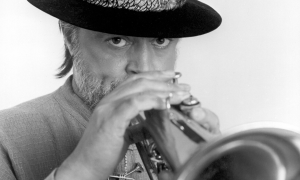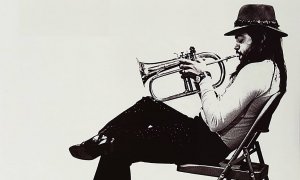Home » Jazz Articles » Catching Up With » Ralph Lalama: A Disciple, Not a Clone
Ralph Lalama: A Disciple, Not a Clone

Courtesy John Abbott
It takes a lot of discipline to have the right to be free.
—Ralph Lalama
Lalama grew up surrounded by a loving, hard-working, musical family in the rough-edged, steel mill town of West Aliquippa, Pennsylvania. "My paternal family originally came from north of Rome, Italy, from the Abruzzo region. I was named after my great grandmother, Rafaela. My father Nofrey, Jr., was a drummer. He worked in the steel mill all day and played gigs just about every night. My mother, Jennie, was a registered nurse and a professional singer who worked in my father's band, right up until the time I was born. My grandfather, Nofrey, Sr., was the State Auditor of Pennsylvania, who also played alto and clarinet. When I was nine years old, he gave me a clarinet. My Uncle Dominick was a trumpet player. Uncle Tony was a pianist and a lawyer. My younger brother, Dr. Dave Lalama, is a jazz pianist, composer, arranger and conductor. He arranged for Woody Herman. When I turned fourteen, my father bought me my first tenor saxophone. I started gigging as a teenager, playing with funky soul bands and in the concert band."
All of his family's musical genes poured into Lalama After graduating Youngstown (Ohio) State University with a music degree, he leapt at the chance to move to New York City. The encouragement to do so came from Thad Jones, the legendary trumpeter, composer and arranger, who had traveled to play at YSU and to conduct a jazz clinic. In his last semester as a senior, the Music Department had asked Lalama to be Jones' chauffeur—a serendipitous encounter that would impact the course of Lalama's musical future. During his stay, Jones got the opportunity to hear Lalama play. He advised the young man, "You know, if you're really serious about this music, you should move to New York." Three months later, Lalama made his way there. "When I got to New York I called Thad Jones on the phone. Right off the bat, he gave me a bunch of gigs with him. The next thing I knew I was gigging with Thad, Walter Norris on piano, George Mraz on bass and Mel Lewis on drums. I was, like, 'Wow!'"
Perhaps because his father was a drummer, Lalama learned early on to "respect the beat." No doubt this led him to become a favorite with many drummers throughout his career. Mel Lewis tapped him early on to join his jazz orchestra. He toured and recorded with Buddy Rich and Joe Morello. More recently, drummers such as Rodney Green and Joe Barna have given him gigs at their clubs. His advanced mastery of rhythm is notable in his solos, which have rhythmic variety, pauses, dynamic accents and surprising phrasing, influenced by the stream-of-consciousness lines of bebop masters but also by short, explosive, funky riffs that combine to give him his distinctive, down—to-earth style. He has remained in New York City for decades and he has a big city sound and attitude. Lalama has become a long-time mainstay at NYC's famed Smalls Jazz Club with his trio, Bop Juice.
All About Jazz: Your instrumentation with your trio Bop Juice has changed. Now you are using Akiko Tsuruga, organist, who worked with Lou Donaldson.
Ralph Lalama: It started when I met [trumpeter] Joe Magnarelli's wife. I heard her with Lou [Donaldson], and one day, I said, "Maybe we should play together at Smalls." She plays the bass with her foot, and chords, and is very swinging. We did a couple of gigs. The original Bop Juice was just me, bass and drums. Bass players get very busy, gig-wise, and they come and go. So I thought, "Let's try Bop Juice with an organ." So now, it's Akiko and Clifford.
AAJ: The pandemic changed the music scene so much, but now that it's ebbing, you seem to have reemerged at a lot of clubs in the Tri-State Area.
RL: Mitch [Borden], the guy who originally owned Smalls, started a club in Bushwick, Brooklyn called Ornithology. I've been working there a lot with Akiko and Clifford. Also, I play the Village Vanguard every Monday night with the Vanguard Jazz Orchestra, since 1983, 40 years as a regular, after subbing on the band for a few years. I've been a long- time member of Joe Lovano's Nonet; we typically play at Birdland. George Garzone, (tenor saxophonist) and I played up in Troy, NY, with the Joe Barna Trio. We're featured in a so-called "Tenor Battle." Rodney Green, the drummer, owns a club in Teaneck, New Jersey, called "Brush Culture." Two talented former students of mine who graduated from SUNY Purchase, Sameer Shankar and Simon Ribas, played with me there.
AAJ: How did you cope during the pandemic when all the clubs were shut down and all the gigs stopped?
RL: When the pandemic hit, I did catch the virus early on, while I was on tour in Europe. We had to cut the tour short and high-tail it back to New York. I came down with it just after I got back. I was able to stay home and recover slowly. One morning my wife commented that what it felt like during the shutdown was that we are on a "Staycation." I got a kick out of that idea. So I went to the piano and wrote a tune by the same name. I called Nils Winther at Steeplechase Records and through him arranged a recording session for a project, dubbing it "Staycation: A Family Affair." I called on husband-and-wife team Joe [Magnarelli] and Akiko [Tsuruga], and lastly Clifford [Barbaro], whom I consider "family," Rounding out the family theme, I asked my wife, Nicole [Pasternak] who is a gifted singer to sing a few tunes, too. She brought a couple of her originals to the project and my brother Dave [Lalama] wrote some originals for it. Plus a few of my own, since I had so much time, not gigging, to focus on composing. During that time on lockdown, a lot of musicians started streaming their performances to try and keep up their chops and make ends meet. One of the first gigs I did was a live stream at Smalls in late 2020. [Owner] Spike [Wilner] paid us some decent bread which was really helpful at that time. We did a live-streaming concert at The Jazz Forum, run by Mark Morganelli in Tarrytown, New York., to benefit the Dobbs Ferry (NY) Food Pantry. Gary Smulyan, John Patitucci, Steve Johns and David Janeway and I played, and Nicole sang. The show was successful and we ended up raising $12,000 to help feed families in our community who were impacted by the pandemic.
AAJ: Do you think music has medicinal powers?
RL: Music definitely ignites the spirit. It makes you forget about your problems. It helps you get away and relax a little. It's a nice escape.
AAJ: What's the difference between practicing and performing?
RL: I think when you practice, that's when you think. You practice the craft and then you play the art. When you play out, you open yourself up and let it go. I'm expressing myself, but there's an audience out there and I'm definitely aware of them. Sometimes the mood is humorous, sometimes it's more serious. It changes. You react to your environment.
AAJ: How did your education help shape your musical life?
RL: Well, I majored in clarinet in college. I was a music major.
AAJ: Were you glad you majored in clarinet in college?
RL: For eight years, I played in the Carnegie Hall Jazz Band under the direction of Jon Faddis. We played quite a few compositions by Duke Ellington. There would be a lot of clarinet, so I was glad I had studied it. We got pretty deep into "Black Brown and Beige," and a couple of years ago when the name of the band changed to the Jon Faddis Big Band, we performed "Such Sweet Thunder." In those two pieces, there's a lot of challenging clarinet parts.
AAJ: Tell me something about how you achieved your unique sound. Somebody online asked what kind of saxophone you used and your mouthpiece.
RL: "I have a Silver Selmer Mark VI. My mouthpiece was crafted by Francois Louis, who also makes ligatures and reeds. He gave it to me 30 years ago, and it did make a difference in my sound. When I first moved to New York, I was into Sonny Rollins. One of my inspirations was his sound, which was what I was working towards. I never got there, but it helped to get me where I am. Another big influence on me was [John] Coltrane. Also, Hank Mobley. Then after a while, I got into developing my own sound. I practice long tones, and an exercise called, "Ha-Ta-Ta." A lot of sax players know about that one. It's a simple idea, but effective. One of the most challenging things for me in terms of finding a decent sound is finding a decent reed!
AAJ: When you compose a set list do you think about emotions and what you want to express?
RL: I make a set with different tempos, different feelings but still with some continuity to it. If I feel like playing a ballad, it's because I feel like playing it at that moment. Keys matter, tempos matter. I don't have an agenda, per se. The tunes might feel different on different days. I don't think about my feelings, I let my feelings happen. I practice the craft and play the art. With the art aspect, I'm not thinking about tune succession. I want the audience to sense the spontaneity of the art. The power of improvisation is the freedom to react. Now, getting back to the importance of constantly and consistently practicing: the more you learn through practice, the more you can create. It's like building your vocabulary. You develop more ways to express yourself, so when you go out to do the art, you feel freer. You have to have a lot of discipline. It takes a lot of discipline to have the right to be free.
AAJ: Turning to your role and experience as an educator. What have you learned from teaching?
RL: It has to be a two-way street. If the kids like to learn, I love teaching. I taught at the University of Vermont (Burlington), at Roni Ben-Hur's Summer Jazz Camp. There were about 35-40 kids or professionals, like doctors, lawyers, a lot of older singers, saxophone players. It's very cross-generational. It's an intensive program, where we hold all-day ensembles, plus a master class for each instrument, dinner and then a jam session at night. We do faculty concerts during the week-nights and then the last two days, Friday and Saturday are the student concerts.
AAJ: You also teach during the school year?
RL: Yes, at SUNY Purchase College. I have private students, repertoire classes, and two ensembles a week, per semester. Sometimes you learn what to do, and what not to do. Sometimes you have kids who know a lot, and I learn things about playing saxophone. I am very encouraging, at least, I always try to be, but I'm honest with them and tell the truth. Sometimes I say, "You're wasting your parents' money," if, after nine weeks in a row, they keep making the same mistakes. Most of the kids have a good head on their shoulders. They realize, "This guy is trying to help me." I try to teach them what they'll need to be good, life-long musicians: to be accountable, responsible, and respectful towards themselves, their fellow students and certainly towards the music.
AAJ: How did you and your wife Nicole Pasternak meet? I heard some of your recordings on YouTube and noticed your special arrangements for sax and voice.
RL: I had worked up a circuit in Connecticut and Westchester [County, NY]. Nicole heard me at a festival in Connecticut, in the early 1990s. Then she hired me for a steady gig she had in Connecticut. We both love the standards. That's mainly what she was singing. She's a natural singer with a good ear. I dug the way she sang. We played weddings, parties, and clubs. She used to sing at Birdland with a big band. So, we do our own gigs. She has a career and I have a career but we have done a lot of things together. When we do play together, we have a nice set of arrangements for sax and voice that we have developed over the years.
AAJ: How do you think about the future of jazz?
RL: There's lots of room for moving the art form forward but it still has to have the essence of the "folk song," and by that I mean "the blues." That shouldn't change. You can expand on harmony and rhythm. That's welcome and exciting but it has to respect the roots of this music. Someone might write something and might call it new but to me unless it has that essence of the jazz ideal, some intrinsic sense of swing, it just feels hollow and misses the mark.
AAJ: What's your mission?
RL: My mission is to get better at what I do, my craft, and my art. I want to continue to share my vision with the audience and my students so that this music can live on forever.
AAJ: What is your feeling about the Vanguard Jazz Orchestra?
RL: The band has been playing together a long time and has developed its own distinctive sound. In regards to the saxophone section in particular, everybody knows each other's voice and intonation. The altos are Dick Oatts and Billy Drewes; the tenors are Rich Perry and myself; and the baritone is Gary Smulyan. I get inspired by every one of them. We play well together and apart. Even though everybody has their individual sound, we play together as one. The book of arrangements by Thad Jones, Jim McNeely, Bob Mintzer, Slide Hampton, Jerry Dodgion, Bob Brookmeyer and so many more great musicians and composers, that's what makes being a member of this orchestra such an honor and a privilege for me.
AAJ: Of your own recordings, do you have a favorite?
RL: A favorite CD that I've recorded is Momentum, with Kenny Barron, Kenny Washington, and Dennis Irwin. As far as a solo that I could put up with that I've recorded, I'd have to say I liked the one I did on Wayne Shorter's "Lester Left Town," on Live at the Vanguard, Mel Lewis Jazz Orchestra.
Tags
PREVIOUS / NEXT
Support All About Jazz
 All About Jazz has been a pillar of jazz since 1995, championing it as an art form and, more importantly, supporting the musicians who make it. Our enduring commitment has made "AAJ" one of the most culturally important websites of its kind, read by hundreds of thousands of fans, musicians and industry figures every month.
All About Jazz has been a pillar of jazz since 1995, championing it as an art form and, more importantly, supporting the musicians who make it. Our enduring commitment has made "AAJ" one of the most culturally important websites of its kind, read by hundreds of thousands of fans, musicians and industry figures every month.
























